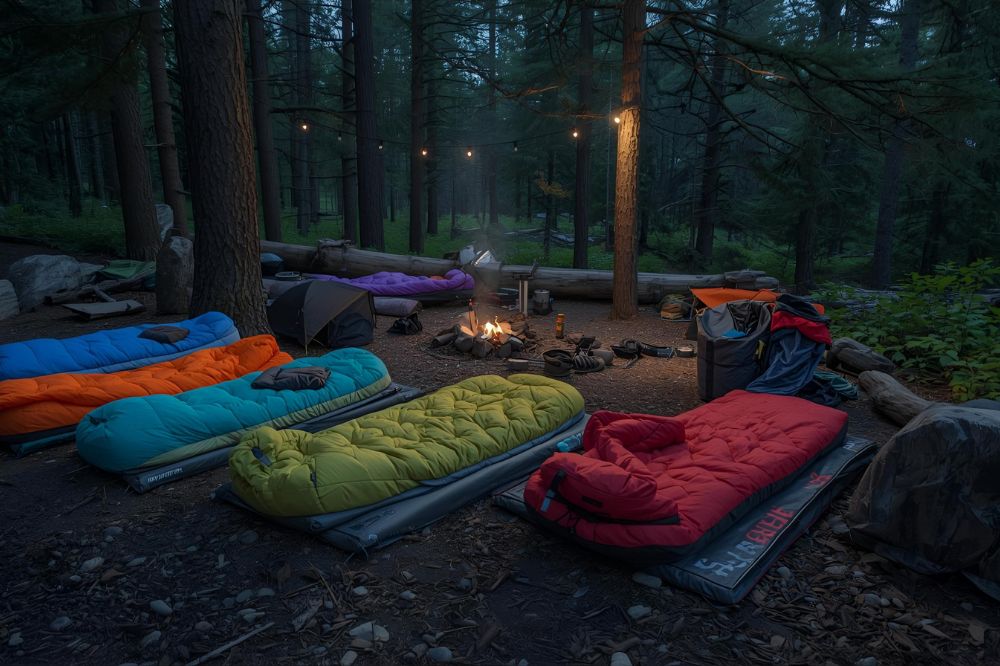Sleeping bags are, well, pretty much indispensable for anyone spending time outdoors. Honestly, their quality can make or break your night—I’ve had nights where a cheap bag left me shivering, and let’s just say, it wasn’t fun. In harsher or more dangerous environments, a sleeping bag isn’t just about comfort—it can actually be life-saving. So, picking the right one really matters, especially if you’re heading somewhere unfamiliar or extreme. Let’s dive in and take a closer look at sleeping bags.

What is a Sleeping Bag?
At its simplest, a sleeping bag is… well, a bag you sleep in. Easy, right? But there’s more to it. Most modern sleeping bags will list two temperatures: comfort and extreme.
- Comfort temperature: The range where you can sleep all night without freezing—or sweating too much. The “upper comfort” point is basically when you feel cozy but aren’t overheating. Usually, this is measured with the zipper open, arms out, and the hood loose. Sounds specific? It is.
Over time, different countries and brands have created their own testing standards. The UK, France, Germany, Norway, the US, Switzerland… all have their methods, and yes, people debate which is “best.”
Honestly, most high-quality sleeping bags aren’t wildly different in practice. But remember—these temperatures are tested in ideal conditions. In real life? You might find it a few degrees colder than advertised. I’ve certainly experienced that a couple of times, so don’t be surprised.
Common Sleeping Bag Materials
Outer Materials
- Synthetic hollow fiber
Lightweight and moisture-resistant. Good for humid environments. But here’s the catch: if it gets wet, sleep quality drops fast. - Down
Super lightweight and excellent insulation. Must stay dry—wet down is basically useless, and drying it can be tedious. Learned that the hard way on a rainy hike. - Camping sack
Can partially replace a tent to stay dry… sort of. Honestly, a tent is usually more practical—it provides a place to cook and move around.
Storage tip: Compression or small sacks help reduce bulk. And a clean sleeping bag is a happy sleeping bag—use a ground pad or rain cover if needed.
Inner and Outer Fabrics
- Most standard bags use polyester or nylon; the difference is mostly in density and feel.
- Down bags require high-quality fabrics (usually nylon 230T or higher) to prevent leakage. Some cheaper versions use coatings—okay in a pinch, but not ideal.
- Breathability matters. Trapped moisture kills insulation.
- High-thread-count cotton can help, but it’s heavy and bulky, so you rarely see it in premium sleeping bags.
Types of Sleeping Bags
Fleece Sleeping Bags
- Made from fleece. Great alone in summer—or as a liner for hygiene.
- Combine with other sleeping bags in cold conditions to boost warmth. From experience, adding a fleece liner to a -3℃ bag can feel like +5℃.
- Comfort range: roughly +10℃ to +25℃.
Down Sleeping Bags
- Usually duck or goose down. Goose down tends to insulate slightly better.
- Key things to know:
- Fill weight (e.g., 400g goose down vs. 1100g duck down)—it’s the filling weight, not total bag weight.
- Down content: feathers give structure, fine down traps heat.
Down-Cotton Hybrid Bags
- Mix of down and cotton. The back uses cotton to avoid that “compressed down” feel, while the top uses down for warmth.
- Price-wise, these sit between full-down and full-cotton options. A nice compromise if you can’t decide.
How to Choose an Outdoor Sleeping Bag
Step 1: Pick a Sleeping Bag Based on Your Travel Plan
A sleeping bag is often one of the bulkiest things in your luggage. You might think comfort is the main thing—but how compact it is and how easily it compresses can matter even more, especially if you’re hiking or traveling light.
Ask yourself:
- What kind of environment are you heading into?
- Which season will you be traveling?
- What kind of weather might you face?
Combine those answers to narrow down your options. For example, if you’re leaning toward a down sleeping bag:
- Extreme weather: Goose down bag with 2000g fill, 90% down content, and a draft collar to keep neck heat in.
- High-altitude summer (night temps around -15°C): Something with 1200g fill and 80% down content might work.
These are just general pointers. Everyone’s different—your metabolism, sleeping habits, and even what you eat before bed can change how warm you feel. I’ve found that two people in the same bag under the same conditions can have very different nights.
Step 2: Choose the Right Warmth (Comfort Level)
Warmth, or comfort level, is basically the temperature range where you’ll actually sleep well. Most sleeping bags list three points:
- Lowest (limit) temperature: Coldest you can safely survive.
- Comfort temperature: Where you can realistically sleep through the night.
- Highest temperature: Above this, you’ll overheat—nobody likes waking up drenched.
How to pick:
- Estimate expected camping temperatures. Most casual trips fall between –7°C and +7°C, but it varies.
- Adjust based on personal preferences—some feel cold easily; others don’t.
- Match a sleeping bag to the adjusted temperature and check the manufacturer’s comfort rating.
Tip: When in doubt, choose a bag rated slightly colder than expected. It’s easier to unzip a bag if you’re too warm than to wake up shivering in the middle of the night.
Step 3: Consider the Insulation Material
Insulation determines weight, volume, compressibility, and durability. Most sleeping bags use either natural down or synthetic fibers.
1. Natural Down
- Quality depends on goose vs. duck down—goose is fluffier and warmer.
- Loft (puffiness) affects warmth.
- Pros: Lightweight, compressible, excellent warmth, long-lasting.
- Cons: Absorbs moisture, hard to dry when wet, expensive.
2. Synthetic Materials
- Modern hollow fibers are far better than old polyester fills.
- Pros: Performs better when wet, dries faster, cheaper.
- Cons: Less warmth and durability in cold, dry conditions.
In damp areas, synthetics might feel safer. But for weight and warmth, down usually reigns supreme.
Step 4: Pick the Right Shape
Shape affects warmth, comfort, and packed size.
- Mummy Shape: Narrow, tapered from shoulders to feet, with a snug hood. Most heat-efficient but can feel restrictive.
- Semi-Rectangular Shape: Slightly roomier than mummy, still good insulation. A balance between comfort and warmth.
- Rectangular/Envelope Shape: Prioritizes comfort and space, not warmth. Good for warm weather, bulkier to carry in cold conditions.
Side note: Modern designs often have small, square hoods and streamlined bodies—wider at shoulders and elbows than the neck. Old-school, large round hoods are heavier and less heat-efficient.
Sleeping Bag Cleaning Precautions
Cleaning a sleeping bag isn’t complicated—but it does require care. One wrong move, and all that cozy insulation could get ruined.
- Detergent: Use neutral soap or a cleaner made specifically for sleeping bags. Avoid bleach or fabric softeners—they damage insulation.
- Spot clean first: Soak briefly and use a soft brush for dirty areas (head, collar, foot).
- Machine wash: Use a front-loading washer only. Top-loading agitators can damage fabric. Turn the bag inside out, zip up, fasten buckles, and use warm water on the gentle cycle. Skip spin-dry.
- Rinse thoroughly: Leftover detergent can affect insulation.
- Handling wet bags: Support from the bottom when lifting. Lifting one end can tear fabric or lining.
- Frequency: Don’t wash too often—once or twice a season is usually enough unless it’s very dirty. Use a liner and ground pad to reduce dirt.

Hi, I’m Clara Morgan, and I started this site out of a love for spending time outside—whether it’s backyard gatherings, camping trips, or cozy evenings under the stars. Over the years, I’ve learned that the best memories come from simple, meaningful outdoor experiences rather than expensive vacations or complicated plans.
This website was created to share those experiences and help more people enjoy outdoor living with ease and confidence. Whether you’re a parent searching for safe camping gear, a couple planning a weekend getaway, or someone looking to transform your backyard into a cozy retreat, this site is your go-to resource.
